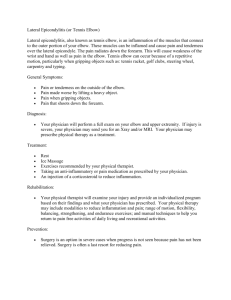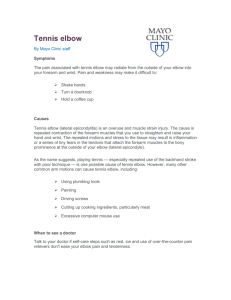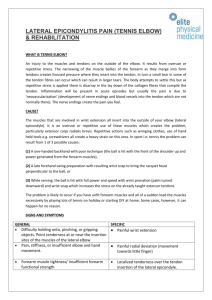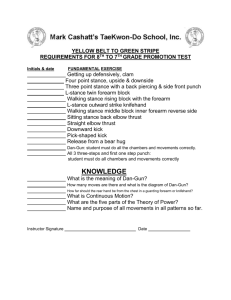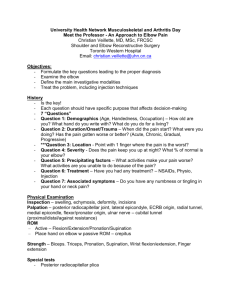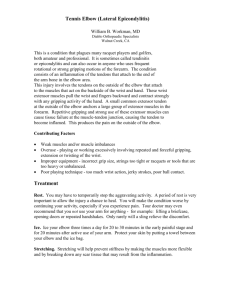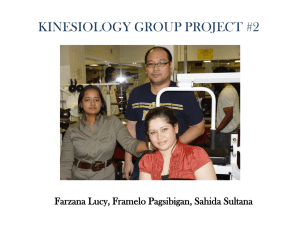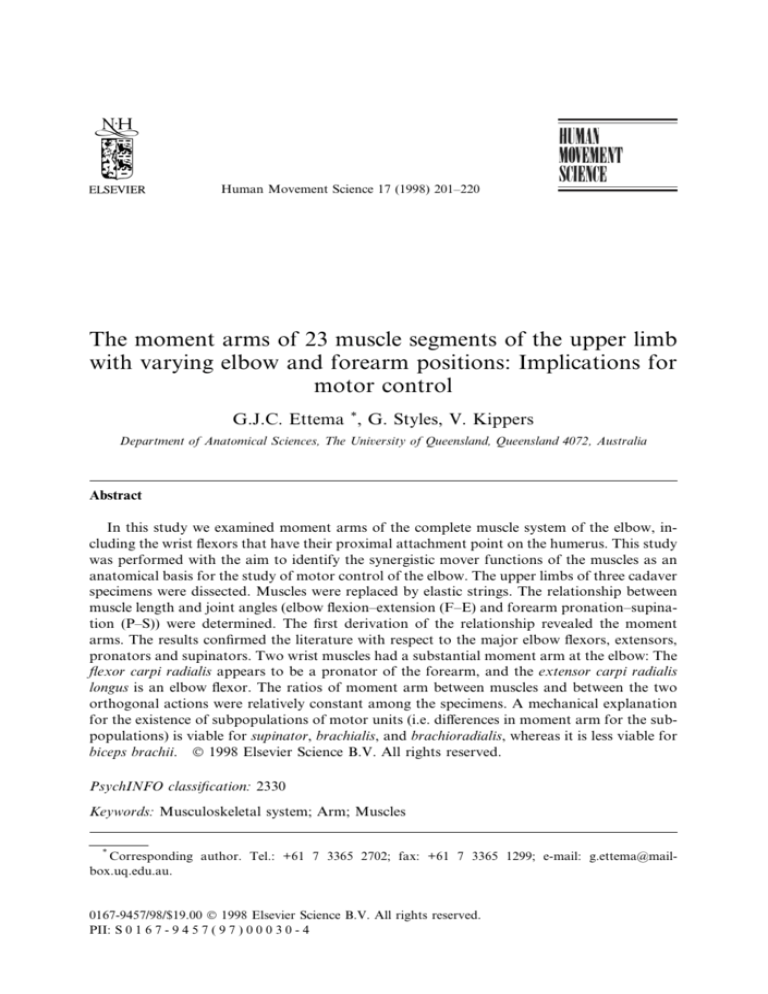
Human Movement Science 17 (1998) 201±220
The moment arms of 23 muscle segments of the upper limb
with varying elbow and forearm positions: Implications for
motor control
G.J.C. Ettema *, G. Styles, V. Kippers
Department of Anatomical Sciences, The University of Queensland, Queensland 4072, Australia
Abstract
In this study we examined moment arms of the complete muscle system of the elbow, including the wrist ¯exors that have their proximal attachment point on the humerus. This study
was performed with the aim to identify the synergistic mover functions of the muscles as an
anatomical basis for the study of motor control of the elbow. The upper limbs of three cadaver
specimens were dissected. Muscles were replaced by elastic strings. The relationship between
muscle length and joint angles (elbow ¯exion±extension (F±E) and forearm pronation±supination (P±S)) were determined. The ®rst derivation of the relationship revealed the moment
arms. The results con®rmed the literature with respect to the major elbow ¯exors, extensors,
pronators and supinators. Two wrist muscles had a substantial moment arm at the elbow: The
¯exor carpi radialis appears to be a pronator of the forearm, and the extensor carpi radialis
longus is an elbow ¯exor. The ratios of moment arm between muscles and between the two
orthogonal actions were relatively constant among the specimens. A mechanical explanation
for the existence of subpopulations of motor units (i.e. dierences in moment arm for the subpopulations) is viable for supinator, brachialis, and brachioradialis, whereas it is less viable for
biceps brachii. Ó 1998 Elsevier Science B.V. All rights reserved.
PsychINFO classi®cation: 2330
Keywords: Musculoskeletal system; Arm; Muscles
*
Corresponding author. Tel.: +61 7 3365 2702; fax: +61 7 3365 1299; e-mail: g.ettema@mailbox.uq.edu.au.
0167-9457/98/$19.00 Ó 1998 Elsevier Science B.V. All rights reserved.
PII: S 0 1 6 7 - 9 4 5 7 ( 9 7 ) 0 0 0 3 0 - 4
202
G.J.C. Ettema et al. / Human Movement Science 17 (1998) 201±220
1. Introduction
The upper limb is often used as a model to study motor control because of
the `redundancy of degrees of freedom problem' formulated by Bernstein
(1967). The elbow joint may be considered a compound joint, containing
three pairs of articular surfaces (humeroulnar, radiohumeral, and radio-ulnar) within its joint capsule. Fifteen muscles have actions involving motion
at these joints. In theory, the number of solutions for performance of a particular motor task involving elbow movement is in®nite; a wide variety of
joint movements produced by a wide variety of muscle activation patterns,
can be used to perform a single task. Yet, the neuro-motor system seems
to have few problems dealing with this redundancy of choices. Many hypotheses have been formulated to deal with this issue (see Gielen et al., 1995 for a
review). One of the theories regards the anatomical and mechanical constraints of the musculoskeletal system, including constraints regarding stabilisation of joints (e.g. Kumar et al., 1989), stress distribution in joints
(Pauwels, 1980) and biarticular muscle actions in multi-joint movements
(van Ingen Schenau, 1989).
To understand the impact of these mechanical constraints on motor behaviour the mechanical system needs to be described quantitatively. In this
respect, reliable estimates of moment arms of muscles are crucial so that muscle performance (force and moment generation) can be estimated accurately.
In many studies, moment arms of muscles of the elbow have been investigated (e.g. Braune and Fischer, 1889; Wilkie, 1950; Murray et al., 1995;
An et al., 1981; Zuylen et al., 1988a; Kawakami et al., 1994). Most studies
on the elbow system investigated only a few muscles (e.g. Murray et al.,
1995; Zuylen et al., 1988a; Kawakami et al., 1994) or investigated the changes
of moment arms with joint angles using simplistic (trigonometrical) models
of the elbow assuming a ®xed centre of rotation in the centre of the trochlea
(e.g. Wilkie, 1950; An et al., 1981; Zuylen et al., 1988a; Kawakami et al.,
1994). Particularly, the interaction of elbow ¯exion angle and forearm position (supination±pronation (S±P)) on moment arms is an interesting issue
that has hardly been investigated. Murray et al. (1995) found that the biceps
moment arm for elbow ¯exion changed with forearm position. Their data,
however indicate that the interaction eects are relatively small and may be
functionally insigni®cant. Yet, interactions of similar magnitude may be of
enormous functional importance for muscles with a small moment arm in
the pronation±supination (P±S) action. Furthermore, interindividual dierences regarding the details of eects of joint positions on moment arms are
G.J.C. Ettema et al. / Human Movement Science 17 (1998) 201±220
203
important for understanding interindividual dierences in muscle activity
patterns during motor tasks of the elbow.
In this study we aimed to investigate moment arms of the complete muscle
system of the elbow and forearm, including the wrist ¯exors that have their
proximal attachment point on the humerus. This study was performed with
the aim to identify the synergistic mover functions of the muscles. We concentrated on elbow and forearm positions around the mid-range of motion
for two reasons. First, positions in the mid-range of motion are the most frequently occurring ones during daily life and many laboratory research situations (e.g. Jamison and Caldwell, 1993; Zuylen et al., 1988b; Sergio and
Ostry, 1995). Secondly, our methodology of measurement involved replacing
muscle segments with quasi-volumeless strings. For the mid-range of motion,
it can be reasonably assumed that higher order eects caused by muscle volume, and not accounted for by our methods, are small.
The purpose of the present investigation was to determine the relationships
between elbow and forearm positions and distances between muscle attachment sites. The measured length changes of representative parts of muscles
crossing the elbow joint, in cadaver specimens, allowed calculation of moments arms of the muscles. Of particular interest were the analyses of interaction eects of elbow and forearm position on muscle moment arms and
interindividual dierences.
2. Methods
2.1. Model
To determine moment arms for elbow and forearm movements, the function l f(a), where l is the 23-dimensional vector of muscle lengths, and a the
two-dimensional vector of joint angles, was estimated by a third order polynomial including cross-product (2nd and 3rd order). Main eects of joint angles were determined by truncation of the polynomial, i.e. excluding the
cross-product from the ®tting Eq. (1b). The moment arms are the Jacobian
matrix of l f(a). Thus, the general equation was:
l a3 e3 a2 e2 a1 e b3 /3 b2 /2 b1 / c3 e /2
c2 e2 / c1 e / O;
l a3 e3 a2 e2 a1 e b3 /3 b2 /2 b1 / O;
1a
1b
204
G.J.C. Ettema et al. / Human Movement Science 17 (1998) 201±220
where a3 , a2 ,. . .,c2 , c1 ,O are the ®tting parameters. A third order polynomial
was chosen as a compromise between sucient degrees of freedom in the
model to properly describe changes in moment arms and sucient reduction
of noise in the data (see Spoor et al., 1990). For the ®tting procedures all angles were expressed in radians. Partial derivation of the equation results in the
¯exion±extension (F±E) and P±S moment arms as function of elbow angle
and forearm, position, respectively:
dl=de 3a3 e2 2a2 e a1 c3 /2
2c2 / e c1 /
including cross-product;
dl=d/ 3b3 /2 2b2 / b1 2c3 e / c2 e2 c1 e;
dl=de 3a3 e2 2a2 e a1
excluding cross-product;
dl=d/ 3b3 /2 2b2 / b1 :
When the interaction is included in the ®t (full third order expansion) the
moment arms for one action (i.e. F±E or P±S) diers as a function of both
joint angles. The joint angles and moment arms were de®ned as follows.
The included angle was used as a measure for elbow angle, i.e., full elbow extension is about 180°. Supination was de®ned as a positive angle and pronation as a negative angle, the mid-prone position being zero. Thus,
dierentiation of Eqs. (1a) and (1b) results in ¯exion and pronation moment
arms that are positive, and extension and supination moment arms that are
negative.
2.2. Experimental techniques and protocol
The upper limbs of three cadaver specimens (embalmed in a formaldehyde
solution for at least six months) were dissected by removing muscles after the
attachment points were indicated and marked. For muscles with large attachment sites, they were divided into segments, named by the proximo-distal positioning of the proximal attachment site (see Table 1). The division and
location of attachment sites of muscle segments was based on the size of
the whole attachment site. Thus, the proximal segment represented the most
proximally placed ®bre bundle of the muscle, the distal segment represented
the most distally placed bundle, and the intermediate segment represented the
geometric average in the proximo-distal direction. The ligaments of all joints
were left intact as much as possible. In some cases, ligaments and interosseus
G.J.C. Ettema et al. / Human Movement Science 17 (1998) 201±220
205
Table 1
The muscles and their segments investigated in this study
Muscle
Segments
Abbreviation
Triceps Brachii Long Head
Triceps Brachii Medial Head
)
Proximal
Distal
Proximal
Distal
)
)
Proximal
Intermediate
Distal
Proximal
Distal
Proximal
Intermediate
Distal
)
Proximal
Distal
)
)
)
)
)
TBlh
TBm-p
TBm-d
TBl-p
TBl-d
BBl
BBs
B-p
B-i
B-d
BR-p
BR-d
S-p
S-i
S-d
PT
PQ-p
PQ-d
FCR
FCU
ECRl
ECRb
ECU
Triceps Brachii Lateral Head
Biceps Brachii, Long Head
Biceps Brachii, Short Head
Brachialis
Brachioradialis
Supinator
Pronator Teres
Pronator Quadratus
Flexor Carpi Radialis
Flexor Carpi Ulnaris
Extensor Carpi Radialis Longus
Extensor Carpi Radialis Brevis
Extensor Carpi Ulnaris
membranes had to be removed (partly) to allow sucient movement in the
joints of the ®xated specimens. Care was taken that this procedure did not
lead to disruption of the joints. The scapula was ®xated onto the humerus
in the anatomical position by a screw connecting the acromion and the head
of the humerus. All muscles were replaced by elastic strings which were attached to the bones by small screws (é 3 mm). The strings representing muscles of the wrist were attached to the radius or ulna at the level of the carpal
grooves/tunnels. The hand was ®xated to the radius in the anatomical position by means of a metal plate connecting the third metacarpal bone to the
radius.
The elbow and forearm angles were measured by steel rods that were connected onto the humerus and ulna, and ulna and radius, respectively
(Fig. 1(A)). The angles between these rods were measured by adapted goniometers (accuracy 1°), minimising parallax in case the two rods did not run in
exactly the same plane. At reference angles of elbow (120°) and forearm (midprone) the angles between the rods were measured to allow conversion from
206
G.J.C. Ettema et al. / Human Movement Science 17 (1998) 201±220
Fig. 1. (A) Experimental setup. The femur was held by two clamps (one visible, marked `k'). Two rods
marked `c' were used to ®x the radius and ulna in the required position with the aid of magnetic bases
`b'. Four rods marked `*' were used to measure elbow angle and forearm position. The metal plate ®xing
hand and radius is marked `f'. (B) Schematic representation of measurement of elbow angle (e0 ) and forearm position (/0 ), using rods attached to humerus (H), radius (R), and ulna (U). Angles were converted to
true angles (e, /) as described in the text. In the case that the two rods through the mid-shaft of radius and
ulna were almost parallel, a 90° angled rod was used. (C) The matrix of combinations of elbow angle and
forearm position that were measured (three open boxes) and the range that was used in the statistical analysis (®lled box).
the measured rod angles (e0 , /0 ; Fig. 1(B)) to actual elbow (e) and forearm (/)
angles. The elbow angle was measured between humerus (acromion ± lateral
epicondyle) and forearm (olecranon ± styloid process ulna), and the forearm
position by position of the styloid processes of ulna and radius in the vertical
plane.
The humerus was ®xed vertically in a stand. The ulna and radius were connected via rods to magnetic bases. The magnetic bases allowed easy alteration
of elbow and forearm positions, yet providing a stable ®xation during measurement (Fig. 1(A)). The elbow angle was changed in steps of 5° between
measurements. The forearm angle was changed in steps of 10° at each elbow
G.J.C. Ettema et al. / Human Movement Science 17 (1998) 201±220
207
joint angle. At each subsequent elbow angle position, the starting forearm
joint angle diered 5° from the previous one. Thus a matrix of elbow and
forearm measurement positions was obtained with a joint angle step of 5°
(Fig. 1(C)). Given the ranges of joint angles in all specimens (Fig. 1(C)), it
was decided to investigate the moment arms for a joint angle range of 70±
120° elbow ¯exion, and )30° to 30° forearm position. This range ensured that
errors caused by deviation of the curve ®ttings from the data at the data borders (Ettema, 1997) did not occur.
In each position of the elbow and forearm, the lengths of the elastic strings
were measured using a ¯exible metal tape ruler. The muscle attachment sites
(i.e. start and end of strings) were de®ned as the centre of the screw heads,
which were clearly marked. Thus, string lengths were measured between
the centres of the attachment screws, along the pathway of the string. Where
the strings followed a strong curvature or were partly unapproachable with
the ruler the following solution was used: part of the string was made of inelastic rope, connected to an end-piece of elastic string. Thus, only a measurable, elastic, and clearly marked part of the string needed to be measured to
determine length changes with joint angles. The scale division of the ruler was
1 mm, and the muscle lengths were rounded to the nearest 0.5 mm. Thus, the
reading error amounted to between 0.25 and 0.5 mm.
After the termination of these measurements, osteometric measurements
were taken of humerus, ulna and radius, according to Martin (1957).
2.3. Statistics
The eects of elbow, forearm and cross-product (linear, quadratic, and cubic components lumped) on muscle length were tested for each specimen by
means of ANOVA of the full third order polynomial ®t (p < 0.05). Any signi®cance was interpreted as the actual existence of a moment arm for the
specimen, muscle and joint of interest. It should be noted that this does
not imply that such moment arm exists throughout the range of movement.
3. Results
3.1. General trends
Fig. 2 shows examples of polynomial curve ®ttings and 95% con®dence intervals (full expansion ®t) for four muscles. Muscle lengths are plotted in two
70
95
120
#3
)30
0
30
)30
0
30
R2 -adj.
#2
#3
#1
0
30
Forearm
#1
)30
70
95
120
70
95
120
#2
Elbow
#1
0.0
0.1
0.0
1.2
)0.3
0.1
0.967 0.968 0.994
)0.1 )0.4
0.0
0.1
0.0
0.1
0.5
0.2
)0.1 )0.1
0.0
0.1
*
89.8
58.8
29.6
0.0
0.1
0.0
0.995
*
)0.6 )1.9 )1.4 )9.0
0.1 0.3 0.2
0.0
0.1 0.3 0.2
5.8
*
63.1
37.8
17.7
*
56.3
75.4
63.9
*
*
)6.6 )7.4
)7.3 )7.1
)6.8 )6.3
*
58.9
32.4
15.2
*
35.1
22.8
13.6
*
43.5
57.7
44.3
*
)0.2 )0.7 )0.2 )7.4
0.1 0.3 0.1
)4.6
0.0 0.0 )0.1 0.3
*
32.3
39.6
33.9
*
16.6
24.4
30.4
S-d
*
*
*
7.5 )0.9 )0.6
6.3 )0.1 )0.6
4.9
0.9 0.1
S-i
*
0.7
1.7
1.5
*
8.7
9.0
8.2
*
6.0
8.5
8.7
*
6.1
8.1
9.0
*
9.5
9.7
7.6
*
4.6
8.1
7.7
*
6.8
6.2
4.1
*
*
24.8 )1.3
21.3 )0.4
17.4 )0.1
*
*
10.5
0.0
17.3 )0.1
37.4
1.1
*
6.5
7.8
4.0
*
5.6
5.4
1.1
*
8.3
7.8
7.3
*
8.1
8.8
6,6
*
7.8
6.8
5.4
*
7.3
3.9
1.4
*
51.1
31.4
14.7
*
30.4
35.7
26.9
*
23.6
20.4
14.1
*
19.7
11.3
2.4
*
15.8
17.0
13.9
*
3.4
1.3
0.7
*
*
*
3.0 )0.2 )2.4 )3.4
6.6
1.0
0.6 )1.0
7.0
2.1
1.6 )0.3
*
*
*
*
4.8 )2.6 )2.5 )1.6
5.6
0.4 )0.7 )1.4
5.3
2.1
1.6
0.6
*
*
*
*
2.9 )1.2 )1.9 )1.5
5.1
0.1 )0.6 )1.5
6.4
1.8
0.5 )1.2
*
*
)0.4 11.9
0.3 6.6
)0.1 2.5
*
*
*
0.9 6.2
6.0
1.9 5.4
3.7
)4.0 )4.1 )1.6
*
)0.4
0.2
1.2
*
0.6
0.4
1.2
*
)1.6
2.7
3.4
)0.2
0.0
0.1
*
15.9
7.6
1.3
*
14.6
14.4
4.4
*
3.2
4.2
3.3
PQ-p PQ-d FCR FCU ECRI ECRb ECU
*
*
21.4 )0.9
25.0 )1.6
22.4 )1.4
PT
0.996 0.966 0.959 0.962 0.990 0.978 0.974 0.906 0.687 0.989 0.644 0.534
*
*
*
*
)8.0 )6.8 )4.9 )2.3
0.8 )3.2 )4.7 )2.5
4.6 )2.4 )5.0 )3.4
*
*
*
*
)6.7 )6.2 )6.5 )1.6
)2.8 )7.6 )7.2 )6.1
0.8 )7.6 )5.9 )6.6
*
*
*
*
)7.8 )9.6 )5.3 )2.5
)4.3 )9.4 )4.5 )3.8
0.6 )8.7 )4.8 )5.2
*
*
*
175.5 21.8 )2.3
115.7 13.3
0.1
59.3 4.5
0.4
*
*
*
*
68.8 12.7 )0.2 0.0
91.0 18.9 )1.4 )1.7
79.9 20.4
4.4 0.8
*
78.6
76.3
57.4
BR-d BR-p S-p
*
*
43.5 52.4
38.5 49.7
27.1 37.1
B-p
*
*
0.5 )8.7 )11.0
)0.3 )12.1 )10.3
0.1 )10.0 )8.9
*
28.4
29.5
24.3
*
18.5
17.2
14.5
B-i
*
0.0 )0.1 )0.2 )5.0
)0.1 )0.1 0.0
)2.5
0.0 0.1 0.2
0.7
*
62.1
49.2
30.5
*
44.6
59.2
60.9
*
42.4
46.2
37.8
B-d
*
*
)8.6 )8.8
)7.9 )8.0
)6.2 )6.2
0.1
0.0
)0.1
*
64.1
52.2
32.5
*
48.9
61.7
56.8
*
41.5
44.6
36.3
BBs
0.994 0.994 0.984 0.968 0.990 0.991 0.994
0.1
0.0
0.0
0.7
)0.3
0.0
0.0
0.0
0.0
*
*
)23.2 )26.9
)27.8 )30.1
)24.6 )24.6
*
*
*
)29.0 )28.1 )26.9
)28.9 )29.9 )30.1
)23.3 )26.0 )24.6
0.0
0.0
0.0
*
*
)11.1 )10.4
)27.8 )25.0
)55.1 )41.5
*
*
*
)14.1 )13.6 )10.4
)27.2 )23.7 )23.3
)36.1 )40.6 )45.2
0.0
0.1
0.0
0.0
)0.1 )0.2
*
*
)16.3 )17.6
)20.8 )22.6
)24.8 )24.0
*
*
*
)15.4 )16.1 )15.0
)17.5 )19.2 )19.3
)20.3 )21.1 )22.4
TBlh TBm-p TBm-d TBl-p TBl-d BBl
Table 2
Moment arms for elbow F±E and forearm P±S at three dierent angles. Adjusted R2 and the sum of squares accounted for as percentage of the residual sum
of squares (SScp%) is also given
208
G.J.C. Ettema et al. / Human Movement Science 17 (1998) 201±220
SScp%
R2 -adj.
SScp%
R2 -adj.
SScp%
0.1
0.996
0.5
0.995
0.2
0.1
0.999
0.0
0.996
0.4
0.2
0.968
0.1
0.992
0.4
0.1
0.997
0.0
0.993
0.4
0.0
0.996
0.0
0.992
0.4
15.8* 27.7*
0.997 0.996
59.7* 79.0*
0.986 0.969
11.3 34.4*
BBs
0.1
0.996
0.0
0.992
0.1
B-d
0.2
0.998
0.0
0.984
0.8
B-i
BR-d BR-p S-p
S-i
PT
12.7* 16.2* 17.0* 62.4* 3.0
6.6*
0.974 0.886 0.910 0.997 0.986 0.980
4.5 6.7 15.4* 23.0* 4.3
3.1
0.968 0.971 0.800 0.985 0.968 0.934
0.7 3.3
7.0 17.6* 63.7* 14.9
PQ-p PQ-d FCR FCU ECRI ECRb ECU
5.1 47.5* 23.1*
0.918 0.986 0.972
8.9 15.1* 3.6
0.853 0.969 0.983
8.1 21.0* 3.5
S-d
1.1
43.0* 58.2* 6.3
3.7
1.000 0.997 0.998 0.984 0.932
0.0
10.3* 59.4* 8.7
3.7
0.988 0.967 0.968 0.977 0.886
1.1
4.6
5.4 4.9
1.1
B-p
Moment arms are based on the truncated polynomial ®t (excluding cross-product). R2 is adjusted for degrees of freedom. (*) Signi®cance for moment arms
and the elbow-forearm interaction(cross-product) is based on statistical signi®cance of eect of joint angle on muscle length (ANOVA of the polynomial ®t,
p < 0.05).
#3
#2
TBlh TBm-p TBm-d TBl-p TBl-d BBl
Table 2 (Continued)
G.J.C. Ettema et al. / Human Movement Science 17 (1998) 201±220
209
210
G.J.C. Ettema et al. / Human Movement Science 17 (1998) 201±220
Fig. 2. Examples of full expansion polynomial ®ttings (and 95% con®dence intervals) of muscle lengths as
function of elbow angle and forearm position. Insets show enlargements of segments of the ®ttings. The
data are presented in two ways. Primary joint angles are indicated on the horizontal axes, secondary joint
angles forearm (F) and elbow (E) are indicated in the diagrams. The arrows indicate increasing angle and
thus point towards extension (elbow) and supination (forearm). The tangents of segments indicate the moment arms for the respective joints. The 95% con®dence intervals for the tangents were in the centre of the
segments approximated by the 95% con®dence intervals of the length curve. At mid-prone position and
95° elbow ¯exion the 95% interval were: PT, P±S: 9.01 ± 7.60 mm; F±E: 22.49 ± 21.09 mm. BBl, P±S:
)5.77 ± )8.89 mm; F±E: 51.81 ± 48.69 mm. TBlh, P±S: 0.50 ± )0.52 mm; F±E: )27.63 ± )28.64 mm.
S±P, P±S: )3.07 ± )4.16 mm; F±E: 22.49 ± 21.09 mm.
ways, indicating the length change with forearm position at dierent elbow
angles (top diagrams) and indicating the length change with elbow angle at
dierent forearm positions (bottom diagrams). The F±E and P±S moment
arms are the respective tangents of the curves. The diagrams for biceps brachii
(long head) and pronator teres seem to indicate interaction eects, i.e. the
supination moment arm changes with elbow angle. The statistical analysis
of these results is shown in Table 2.
G.J.C. Ettema et al. / Human Movement Science 17 (1998) 201±220
211
All muscles of all three specimens were signi®cantly aected by elbow angle, and thus had a signi®cant moment arm in the F±E direction (Table 2).
The pronator quadratus and the intermediate and distal segments of the supinator do not attach to the humerus. The eect of elbow angle on their
lengths may be explained by detailed analysis of kinematics of the elbow.
For example, the rotation axes of P±S and F±E are not completely orthogonal (Veeger et al., 1997) and may show some interdependence. However, the
eects were small and not consistent over elbow angle and amongst specimens.
Apart from triceps brachii and brachialis, all muscles were aected by forearm position. However, the P±S moment arms for most of the wrist muscles
(FCU, ECRl, ECRb and ECU) are small and inconsistent. It should be noted
that in two specimens the brachioradialis acts as a supinator in forearm positions up to 30° Only one specimen showed the generally accepted pattern
that the brachioradialis draws the forearm toward the mid-prone position
(i.e. supinates in pronation position and vice versa; see Murray et al., 1995).
3.2. Interactions
Signi®cant interactions were found for biceps brachii, brachioradialis, pronator teres, FCU and ECRl. The interaction that appeared to be substantial
and of possible functional signi®cance is shown in Fig. 3. The supination moment arm of biceps brachii decreases with elbow extension, which is in agreement with the review by Stroyan and Wilk (1993). A small eect of forearm
position on the ¯exion moment arm is also indicated. In two specimens, the
brachioradialis supination moment arm is lost in elbow extension. The pronator teres has its largest pronation moment arm when the elbow is ¯exed,
whereas its ¯exion moment arm reduces slightly toward the supinated forearm position.
3.3. Proportions
For only one F±E moment arm was a clear correlation found with osteometric data that seemed to bear a direct physical relationship with the speci®c
moment arms. The F±E moment arm of brachioradialis correlated well with
maximum ulna and humerus length (r 0.998 and 0.904, respectively). For
the P±S moment arms some more apparent relationships were found. The
P±S moment arms of the brachioradialis, supinator and pronator teres correlated well with the (average of sagittal and transverse) mid-shaft diameter of
212
G.J.C. Ettema et al. / Human Movement Science 17 (1998) 201±220
Fig. 3. Interaction of elbow angle and forearm position on moment arms. The P±S moment arms are at a
mid-prone (0°) forearm position. The F±E moment arms are at an elbow angle of 95°; markers indicate the
specimens.
the radius (r ranging from 1.000 to 0.927), whereas the P±S moment arms of
the pronator quadratus and ¯exor carpi radialis correlated with the (maximal
posterior±anterior) diameter of the ulna.
The relationships among moment arms of dierent muscles and between
F±E and P±S moment arms are presented in Table 3 as ratios. Ratios were
only calculated for moment arms that were statistically signi®cant and consistently of substantial size (Table 2). In many cases, the ratios appeared to
vary relatively little among specimens. However, the F±E over P±S ratio of
the proximal part of the supinator and FCR, and the P±S ratios of brachioradialis, pronator teres and pronator quadratus over biceps brachii, varied
widely around the equality value. Also shown in Table 3 are ratios of moments that can be generated by the muscles. The moments are based on
cross-sectional areas reported by Yamaguchi et al. (1990), using data from
An et al. (1979). Thus, these moment ratios can only be used as a rough in-
Mean
Sem
Min
Max
b
2.10
0.74
0.67
3.18
S-P
2.74
0.15
2.45
2.96
PT
1.01
0.26
0.48
1.28
FCR
S
0.89
0.16
0.71
1.21
0.29
a
S
0.65
0.07
0.57
0.79
0.48
S/BB
0.66
0.01
0.65
0.68
1.00
0.25
0.05
0.15
0.31
0.06
0.46
0.05
0.39
0.55
0.34
0.11
0.03
0.05
0.15
0.05
0.08
0.01
0.05
0.10
0.05
P
1.01
0.14
0.76
1.25
0.75
P
0.91
0.15
0.72
1.21
0.44
P
0.65
0.09
0.81
0.51
0.28
S
0.16
0.04
0.23
0.08
0.11
)
)
)
)
0.78
PT/BB PQ/BB FCR/BB ECRb/BB Overall P/S
1.51
0.16
1.31
1.82
0.49
FCR/BB FCU/BB
0.57
0.06
0.47
0.67
0.30
0.18
0.07
0.04
0.28
0.12
0.15
0.03
0.09
0.20
0.11
)
)
)
)
0.59
ECRI/BB ECRb/BB ECU/BB Overall E/F
a
For all moment arms, absolute values were taken to calculate the ratios. The moment arms were averaged over all joint angles, except:
Brachioradialis moment arm for forearm )30° only. Where segments of muscles are not indicated. the average moment arms of the entire muscle
were used. Ratios that showed wide range around 1 are shown in italics.
b
The reported ratios moments are the product of moment arm and physiological cross-sectional area (An et al., 1979 and Yamaguchi et al., 1990).
The cross-sectional are of S±P was taken as a third of the whole supinator. C: The muscles' actions, pronation (P) or supination (S), are indicated for
clarity.
Mean
Sem
Min
Max
Moment
S
1.00
0.01
0.99
1.02
1.01
0.02
0.97
1.05
C
b
0.50
0.03
0.47
0.56
2.06
a
6.47
3.87
1.28
10.37
BR
BBI/BBs B/BB BR/BB S-P/BB PT/BB
5.93
0.46
5.43
6.84
BBs
BBI/BBs BR/BB
Mean
Sem
Min
Max
Moment
TB/BB
6.00
0.59
5.38
7.18
BBI
PS
B
FE
A
FE/PS
Table 3
Ratios of F±E moment arms over P±S moment arms (A), F±E moment arms (B) P±S moment arms, (C) between muscles
G.J.C. Ettema et al. / Human Movement Science 17 (1998) 201±220
213
214
G.J.C. Ettema et al. / Human Movement Science 17 (1998) 201±220
dication of the potential for the muscles to generate torque. However, these
ratios once more stress the signi®cance of ECRl and FCR in elbow ¯exion
and pronation, respectively. The overall E/F and P/S ratios are based on
the summation of all muscles in Table 3. It should be noted that when the
brachioradialis was not included as a supinator (i.e. in mid-prone or supinated forearm position) the P/S ratio equals 0.99.
4. Discussion
The objective of this study was to provide a detailed description of the dependence of moment arms of muscles of the upper limb acting at the elbow
and radio-ulnar articulations. The study included muscles that (presumably)
have their main action at the wrist. The moment arm matrix was based on the
estimated muscle length ± joint angle matrix. This estimate may cause large
errors in moment arm calculations (i.e. ®rst derivation of the polynomial
functions) at borders of the range of measured joint angles (Spoor et al.,
1990; Ettema, 1997). Therefore, the interpretation of the results is limited
to the mid-range of movement and should not be simply extrapolated to other angles. Some good correlations were found between osteometry and moment arms. Thus, the approach used by Murray et al. (1995) to model the
elbow on the basis of osteometry seem viable. Still, interindividual dierences
regarding the exact location of attachment sites, which may be the cause of
other poor osteometry ± moment arm relationships, are not accounted for
in the model by Murray et al. (1995).
It was assumed that the line of pull of each muscle segments was not aected by the volume of the muscles and surrounding tissues, including other
muscles. This may not be the case during activities where many muscles of
the upper limb are highly active. In such cases, muscle segments may have
sucient robustness to aect the line of pull of other segments and muscles.
Yet, it would be hard to quantify such higher order eects.
4.1. General trends
Regarding the three major elbow ¯exors (BR, Brach, BB), the brachioradialis has the largest moment arm, and the brachialis the smallest,
which is in agreement with the literature (e.g. Kawakami et al., 1994). The
triceps brachii has about half the mechanical advantage of its antagonistic biceps brachii (see also Kawakami et al., 1994). The pronator teres seems to
G.J.C. Ettema et al. / Human Movement Science 17 (1998) 201±220
215
have a signi®cant action in ¯exion, whereas the supinator is limited in elbow
¯exion. Furthermore, as documented by others (e.g. Braune and Fischer,
1889; Wilkie, 1950; An et al., 1981), the extensor carpi radialis longus must
be regarded as a signi®cant elbow ¯exor. The contributions of the muscles
in ¯exion are in general agreement with the literature (Kawakami et al.,
1994; Jùrgensen and Bankov, 1971; Edgerton et al., 1986). The ®nding by
An et al. (1981) that the ¯exor carpi ulnaris and ¯exor carpi radialis are extensors of the elbow was not con®rmed in this study. In the movement of
the forearm it appeared that the biceps brachii has the largest moment arm
for supination with the brachioradialis playing a varying role (see below).
Furthermore, the ¯exor carpi radialis appeared to be an important pronator.
In total, ®ve muscles (BB, BR, S±P, PT, FCR) can be described as bifunctional mover muscles with substantial moment arms at both the elbow and radioulnar articulation.
A small number of interaction eects were found between elbow angle and
forearm position on P±S moment arms (Fig. 3). Thus, it seems justi®able to
use relatively simple models, ignoring any interaction, to describe the elbow
system as has been done in many studies. However, it should be noted that
the present study only examined eects in the mid-range of motion. Furthermore, some of the interactions may be important regarding sophisticated motor actions.
4.2. Subpopulations within a muscle
With the exception of the supinator, only few and little dierences were
found among intramuscular segments regarding changes of moment arms
with joint angles. Of course, eects of shoulder con®guration on triceps brachii and biceps brachii actions were not considered in this study. Only the
proximal segment of the supinator, originating from the humerus, has a moment arm for elbow ¯exion. The remainder of the muscle is a pure supinator
of the forearm. The segments of the brachioradialis and brachialis show large
absolute dierences in moment arms, due to the large attachment sites,
whereas the two heads of the biceps brachii show hardly any dierence in this
respect. Such information has direct implications for the interpretation of the
existence of subpopulations of motor units within a muscle (e.g. Zuylen et al.,
1988b; Theeuwen et al., 1996), also referred to as intramuscular task groups
(Loeb, 1985). Task groups are described as a set of motor units (within a
muscle or from several muscles) that are active simultaneously in a particular
motor task, and by this task speci®city are distinguishable from other motor
216
G.J.C. Ettema et al. / Human Movement Science 17 (1998) 201±220
units. Mechanical (moment arms), neural (linearising motor output) and
physiological (®bre types) factors may correlate with the existence of task
groups (see e.g. Loeb, 1985). Assuming that motor units are not randomly
distributed within a muscle belly, the results of the current study would suggest that a mechanical correlation (i.e. dierences in moment arm for the subpopulations) is viable for supinator, brachialis, and brachioradialis, whereas it
is less viable for biceps brachii (see also Theeuwen et al., 1996). Even dierences in motor activity between the two heads of the biceps brachii cannot
be explained on mechanical grounds. Such dierences may be explained by
a dierent (stabilising) action at the shoulder (Kumar et al., 1989).
4.3. Biomechanical constraints of the synergy function
The brachioradialis, which is usually thought of as a muscle that pulls the
forearm towards the mid-prone position, showed varying results among specimens. One specimen showed the previously described behaviour that is in
agreement with the model by Murray et al. (1995). In two out of three specimens the neutral position of the forearm (i.e. where the BR P±S moment arm
changes its sign) was 30° of supination. Such interindividual dierences are
important for the understanding of muscle activity patterns in motor tasks
of the elbow with the forearm held in mid-prone position, such as studied
by e.g. Jamison and Caldwell (1993) and Zuylen et al. (1988b)). The behaviour of the brachioradialis may dier considerably between subjects, depending on the neutral forearm position for this muscle in the P±S direction.
Furthermore, the P/S ratios (Table 3) indicate that consideration of the brachioradialis as a supinator in mid-prone position may strongly aect the mechanical constraints, represented by the P/S overall ratio in Table 3. If the
brachioradialis is considered as a supinator, the potential for the pronators
to work as synergists for biceps brachii and brachioradialis in pure ¯exion
tasks will be limited. It should be noted that the FCR, which contributes
about 20% of the pronator torque, is included in the pronator group. Taking
the changes of the P±S moment arms with forearm position (Table 1) into
consideration, the limitations of this synergistic potential of the pronator
muscles are likely to increase when moving the forearm into pronation. This
is in agreement with elbow ¯exion strength that is reduced in the pronated
forearm position (Jùrgensen and Bankov, 1971; Kulig et al., 1984). In maximum ¯exion tasks the biceps brachii as well as of the brachioradialis are inhibited (up to 50% and 15%, respectively) with the forearm in the pronated
position compared to the supinated position (Jùrgensen and Bankov,
G.J.C. Ettema et al. / Human Movement Science 17 (1998) 201±220
217
1971). The inhibition of the biceps brachii can be explained by its (undesired)
supination action. However, inhibition of the brachioradialis can only be explained mechanically if the neutral forearm position for this muscle is towards supination.
Reciprocal inhibition of the major elbow ¯exors in dierent (dual) tasks
may well be caused, in part, by the mechanical constraints of the musculoskeletal system. Cnockaert et al. (1975) compared F±S, F, and F±P isometric
force tasks. They found highest activity of the biceps brachii and brachioradialis in F±S and lowest in F±P, which is in agreement with the suggestion made above. The fact that both muscles behaved in a similar manner
may well indicate that in the subjects used, the brachioradialis was indeed a
¯exor±supinator, i.e. a full agonist of the biceps brachii in these particular
tasks. Thus the hypothesis of dynamic F-torque sharing between brachioradialis and biceps brachii (Jamison and Caldwell, 1993) may have to
be re-examined. Data from Jamison and Caldwell (1993) are not in full agreement with the suggestions made here, but may still point in a similar direction. They found inhibition of the biceps brachii during the F±S tasks, but
only when the supination force was to be submaximal. A combination of generating maximal ¯exion torque and submaximal supination torque may be
hard to accomplish with a fully active biceps brachii. Still, the mechanical
constraints cannot explain why they (Jamison and Caldwell, 1993) did not
®nd higher activity of biceps brachii and brachioradialis during F±S tasks
compared to the F task.
The E/F overall ratio (0.59, Table 3) suggests a weaker extension potential
than ¯exion, which is in agreement with most literature (review by Kulig et
al., 1984) but not with Kawakami et al. (1994). However, as pointed out
above, the generation of ¯exion torque is often inhibited by the P±S requirements. Such limitations do not exist for extension which only involves the
uni-functional triceps brachii (although the long head is aected by shoulder
position).
4.4. Biarticular wrist muscles
For two wrist muscles, i.e. the FCR and ECRl, the functional implications
of their biarticularity should be considered. Like the biceps brachii and triceps
brachii (long head) they may show activity patterns in multi-joint tasks that
are principally dierent from monoarticular muscles. Biarticular muscles
have the ability (by transporting work between joints) to avoid work dissipation during the control of external force and position in multi-joint tasks (e.g.
218
G.J.C. Ettema et al. / Human Movement Science 17 (1998) 201±220
van Ingen Schenau, 1989; Jacobs and van Ingen Schenau, 1992; Gielen and
van Ingen Schenau, 1992). This function may well be performed by the ECRl
and FCR in tasks that involve the elbow and wrist.
Furthermore, when analysing motor tasks at the elbow, the constraints of
the wrist need to be considered.
4.5. Proportions of moment arms
The invariable ratios of muscle moment arms (Table 3) may suggest that
the human musculoskeletal system of the elbow and forearm is highly specialised for a particular set of (®ne control) tasks requiring a certain set of musculoskeletal actuators that are ®nely tuned with respect to each other. Some
parameters of the system can, of course, be modi®ed by adaptation of muscle
strength. A much larger sample than used in this study is required to substantiate such a hypothesis.
5. Conclusions
Clearly, a full and accurate description of the mechanical properties of the
musculoskeletal lever system cannot explain all synergistic muscle behaviour
described in the literature. Mechanical non-mover functions such as stabilisation of joints and stress distribution (muscles with small moment arms) need
to be considered as well (e.g. Pauwels, 1980). However, like the comparison
between physiological properties of antagonistic and synergistic muscles (e.g.
Roy et al., 1984), a full description of moment arms of the musculoskeletal
system is an essential component for the understanding of the organisation
by the central nervous system.
References
An, K.N., Hui, F.C., Morrey, B.F., Linscheid, R.L., Chao, E.Y., 1981. Muscles across the elbow joint: A
biomechanical analysis. Journal of Biomechanics 14, 659±669.
Bernstein, N., 1967. The Coordination and Regulation of Movements. Pergamon Press, Oxford, New
York.
Braune, W., Fischer, O., 1889. Die Rotationsmomente der beugemuskeln am Ellenbogengelenk des
Menschen. Abh. kgl. s
achs. Ges. Wiss. math.-phys. Kl. 15, 242 [cited by Wilkie, 1950; Jùrgensen and
Bankov, 1971].
Cnockaert, J.C., Lensel, G., Pertuzon, E., 1975. Relative contribution of individual muscles to the
isometric contraction of a muscular group. Journal of Biomechanics 8, 191±197.
G.J.C. Ettema et al. / Human Movement Science 17 (1998) 201±220
219
Edgerton et al., 1986. Speci®c tension of human elbow ¯exor muscles. In: Saltin, B. (Ed.), Biochemistry of
Exercise, vol. 6, pp. 487±500.
Ettema, G.J.C., 1997. Gastrocnemius muscle length in relation to knee and ankle joint angles: Veri®cation
of a geometric model and some applications. Anatomical Record 247, 1±8.
Gielen, C.C.A.M., van Ingen Schenau, G.J., 1992. The constrained control of force and position by
multilink manipulators. IEEE Transactions on Systems, Man, and Cybernetics 22, 1214±1219.
Gielen, C.C.A.M., Bolhuis, B.M., Theeuwen, M., 1995. On the control of biologically and kinematically
redundant manipulators. Human Movement Science 14, 487±509.
Jacobs, R., van Ingen Schenau, G.J., 1992. Control of an external force in leg extensions in humans.
Journal of Physiology 457, 611±626.
Jamison, J.C., Caldwell, G.E., 1993. Muscle synergies and isometric torque production: In¯uence of
supination and pronation on elbow ¯exion. Journal of Neurophysiology 70, 947±980.
Jùrgensen, K., Bankov, S., 1971. Maximum strength of elbow ¯exors with pronated and supinated
forearm. In: J. Vredenbregt, J. Wartenweiler (Eds.), Medicine and sport, vol. 6., Biomechanics II.
Karger, Basel, pp. 174±188.
Kawakami, Y., Nakazawa, K., Fujimoto, T., Nozaki, D., Miyashita, M., Fukunaga, T., 1994. Speci®c
tension of elbow ¯exor and extensor muscles based on magnetic resonance imaging. European Journal
of Applied Physiology and Occupational Physiology 68, 139±147.
Kulig, K., Andrews, J.G., Hay, J.G., 1984. Human strength curves. Exercise and Sport Sciences Reviews
12, 417±466.
Kumar, V.P., Satku, K., Balasubramaniam, P., 1989. The role of the long head of biceps brachii in the
stabilization of the head of the humerus. Clinical Orthopaedics 244, 172±175.
Loeb, G.E., 1985. Motoneuron task groups: Coping with kinematic heterogeneity. Journal of
Experimental Biology 115, 137±146.
Martin, R., 1957. In: Saller, K. (Ed.), Lehrbuch der Anthropologie, vol. 4, 3rd ed. Gustav Fischer Verlag,
Stuttgart [cited by Moore-Jansen, P.H., Jantz, R.L., 1986. A computerized skeletal data bank for
forensic anthropology. Department of Anthropology, University of Tennessee, Knoxville, Tennessee].
Murray, W.M., Delp, S.L., Buchanan, T.S., 1995. Variation of muscle moment arms with elbow and
forearm position. Journal of Biomechanics 28, 513±525.
Pauwels, F., 1980. Biomechanics of the Locomotor Apparatus. Springer, Berlin.
Roy, R.R., Bello, M.A., Powell, P.L., Simpson, D.R., 1984. Architectural design and ®ber-type
distribution of the major elbow ¯exors and extensors of the monkey (cynomolgus). American Journal
of Anatomy 171, 285±293.
Sergio, L.E., Ostry, D.J., 1995. Coordination of multiple muscles in two degree of freedom elbow
movements. Experimental Brain Research 105, 123±137.
Spoor, C.W., van Leeuwen, J.L., Meskers, A.F., Titulaer, A.F., Huson, A., 1990. Estimation of
instantaneous moment arms of lower-leg muscles. Journal of Biomechanics 23, 1247±1259.
Stroyan, M., Wilk, K.E., 1993. The functional anatomy of the elbow complex. Journal of Orthopaedic and
Sports Physical Therapy 17, 279±288.
Theeuwen, M., Gielen, C.C.A.M., Bolhuis, B.M., 1996. Estimating the contribution of muscles to joint
torque based on motor-unit activity. Journal of Biomechanics 29, 881±889.
van Ingen Schenau, G.J., 1989. From rotation to translation: Constraints in multi-joint movements and
the unique role of biarticular muscles. Human Movement Science 8, 301±337.
Veeger, H.E.J., Yu, B., An, K.N., Rozendal, R.H., 1997. Parameters for modeling the upper extremity.
Journal of Biomechanics 30, 647±652.
Wilkie, D.R., 1950. The relation between force and velocity in human muscle. Journal of Physiology 110,
249±280.
Yamaguchi, G.T., Sawa, A.G.U., Moran, D.W., Fessler, M.J., Winters, J.M., 1990. A survey of human
musculotendon actuator parameters. In: Winters, J.M., Woo, S.L.-Y. (Eds.), Multiple Muscle Systems:
Biomechanics and Movement Organization. Springer, New York, pp. 717±773.
220
G.J.C. Ettema et al. / Human Movement Science 17 (1998) 201±220
Zuylen, E.J., van Velzen, A., Denier van der Gon, J.J., 1988a. A biomechanical model for ¯exion torques
of human arm muscles as a function of elbow angle. Journal of Biomechanics 21, 183±190.
Zuylen, E.J., Gielen, C.C.A.M., Denier van der Gon, J.J., 1988b. Coordination and inhomogeneous
activation of human arm muscles during isometric torques. Journal of Neurophysiology 60, 1523±
1548.

